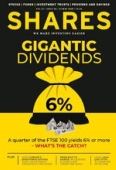Archived article
Please note that tax, investment, pension and ISA rules can change and the information and any views contained in this article may now be inaccurate.
Using low-cost ETFs to generate an income from the market

Investors looking to get a regular income from their portfolio have the option of investing in a range of low-cost exchange-traded funds (ETFs) specifically designed to track certain types of dividend-paying assets.
However, not all dividend-focused ETFs are created equal. In this article we will look at the pros and cons of the relevant products and discuss the mechanics around ETFs and dividends.
TIGHTENING THE RULES
An increasing number of ETFs track a basket of companies which have been filtered according to certain criteria – factors such as volatility, share price momentum and valuation.
Unsurprisingly, given dividends are a key reason many people buy stocks and shares, these factors have also encompassed yield.
While these products can be more expensive than ETFs that simply match the performance of a mainstream index like the FTSE 100, they are typically cheaper than equity income funds. But do they deliver?
The accompanying table shows a section of income ETFs and information on charges and dividend yield.
iShares UK Dividend (IUKD) takes a fairly simple approach of selecting stocks for its index based on dividend yield. Specifically it tracks an index composed of 50 stocks with leading dividend yields from UK-listed companies.
The problem with this approach is that high yields can often be a signal that a dividend cut is on the way. Notably Vodafone (VOD) is among the top holdings within the product and the telecoms group recently cut its dividend by 40%.
For this reason there is an argument that dividend growth or at least sustainability is more important than your starting yield.
SPDR S&P UK Dividend Aristocrats (UKDV) product tracks an index of stocks created by Standard & Poor’s (S&P). It includes the 40 highest-yielding UK firms which have either increased or maintained their dividend payment for at least seven consecutive years.
To be eligible companies also have to meet market cap and liquidity criteria.
The portfolio is rebalanced on a quarterly basis and shares are removed from the index on the first business day of the following month if a dividend is cancelled or suspended.
INDEX PROBLEMS
An error by S&P saw construction group Carillion stay in its index until it went bust in January 2018 despite the company having said in July 2017 it would axe its dividend.
Retailer Marks & Spencer (MKS) is one of the largest holdings in the ETF. It announced a dividend cut in February 2019 but should leave the index at the next quarterly reshuffle in June.
Notwithstanding the Carillion fiasco, we believe the SPDR S&P UK Dividend Aristocrats product is the more attractive option for a long-term investor because of the tighter eligibility criteria for companies to be in the index.
OTHER WAYS TO FILTER THE MARKET
While the Dividend Aristocrats ETF uses backward-looking measures to identify its basket of stocks there are alternatives which try to use forward-looking measures to try to judge the likelihood of a company continuing to pay a high dividend.
One example is BMO MSCI UK Income Leaders (ZILK).
This tracks companies which have higher dividend yields and also rank highly based on index provider MSCI’s quality scores which measure things like the level and consistency of returns and the state of the balance sheet.
A word of caution as this ETF only has £3m in assets. A risk to consider, particularly when looking at smaller niche products, is that the product could be closed down due to lack of interest.
A final consideration is that dividend-focused products are more expensive than traditional broad-market ETFs. Therefore an alternative approach might be to look at a straightforward FTSE 100 ETF given that the blue chip index is yielding 4.7% at present. An example is iShares Core FTSE 100 (ISF) which tracks the index for a low cost of 0.07%.
Important information:
These articles are provided by Shares magazine which is published by AJ Bell Media, a part of AJ Bell. Shares is not written by AJ Bell.
Shares is provided for your general information and use and is not a personal recommendation to invest. It is not intended to be relied upon by you in making or not making any investment decisions. The investments referred to in these articles will not be suitable for all investors. If in doubt please seek appropriate independent financial advice.
Investors acting on the information in these articles do so at their own risk and AJ Bell Media and its staff do not accept liability for losses suffered by investors as a result of their investment decisions.

 magazine
magazine











